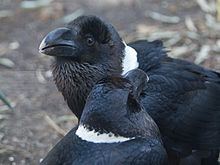- White-necked Raven
-
For the bird formerly known as the American White-necked Raven, see Chihuahuan Raven.
White-necked Raven 
Conservation status Scientific classification Kingdom: Animalia Phylum: Chordata Class: Aves Order: Passeriformes Family: Corvidae Genus: Corvus Species: C. albicollis Binomial name Corvus albicollis
Latham, 1790
Distribution map
The White-necked Raven, Corvus albicollis, is somewhat smaller (50–54 cm in length) than the Common Raven or indeed its nearest relative, the Thick-billed Raven C. crassirostris.Contents
Description
It has a much shorter tail and a deeper bill with a white tip that is strongly arched (almost as much as the Thick-billed Raven). Though predominantly black, the throat, breast and neck are a blackish-brown in colour, with a faint purple gloss. There is a large patch of white feathers on the back of the lower neck.
Soars well with shallower wingbeats than other Corvidae [2]
Measurements
Voice
Often described as a raven with a sore throat, it has very similar calls to the Common Raven, but with a more husky note. It has a croak like the raven but with a more whispering note added.
Distribution and habitat
It occurs in eastern and southern Africa in open, mountainous country. It is quite commonly found in small towns and villages as long as there are mountains or hills for roosting and nesting relatively nearby.
Behaviour
Most of this birds food is obtained from the ground, but it will take food from trees also. It has been seen to drop a tortoise from a height on to hard ground, preferably on rocks, and then swoop down to eat it, or even pick it up again if not sufficiently broken. White-necked Ravens will also readily take carrion from road kills. Fruit, grain, insects, small reptiles, peanuts and human food are also readily taken and if not persecuted, will forage in back yards and gardens quite openly.
Often in the company of other scavengers such as kites or vultures
Nests are a bowl of sticks lined with grass hair and wool found mainly on a cliff ledge but will occasionally nest in a tree. There are usually 3-5 eggs laid.
Photo Image Links
Video links
- White-necked Raven videos, photos & sounds on the Internet Bird Collection
References
- ^ BirdLife International (2004). Corvus albicollis. 2006. IUCN Red List of Threatened Species. IUCN 2006. www.iucnredlist.org. Retrieved on 12 May 2006. Database entry includes justification for why this species is of least concern
- ^ Roberts' Birds of Southern Africa. ISBN 0620175834.
- ^ a b c Roberts' Birds of Southern Africa. The John Voelker Bird Book Fund. pp. 477. ISBN 0620175834.
Extant species of family Corvidae Kingdom: Animalia · Phylum: Chordata · Class: Aves · Subclass: Neornithes · Superorder: Neognathae · Order: Passeriformes Family Corvidae Choughs Treepies PlatysmurusTemnurusOriental
magpiesOld World jays PtilostomusStresemann's
Bush CrowZavattariornis
Categories:- IUCN Red List least concern species
- Corvus
- Birds of Africa
- Ravens
- Birds of Kenya
Wikimedia Foundation. 2010.
Look at other dictionaries:
white-necked raven — ˈ ̷ ̷ˌ ̷ ̷ noun : a raven (Corvus cryptoleucus) of the southwestern United States having the neck feathers white at the base but black at the tips * * * white necked raven «HWYT NEHKT», a raven with a ring of white feathers around the neck, found … Useful english dictionary
white-necked raven — baltasprandis kranklys statusas T sritis zoologija | vardynas atitikmenys: lot. Corvus albicollis angl. white necked raven vok. Geierrabe, m rus. белощёкий ворон, m pranc. corbeau à nuque blanche, m ryšiai: platesnis terminas – varnos … Paukščių pavadinimų žodynas
White-necked — may refer to:* White necked Crow, the largest of the four West Indian Crow species * White necked Jacobin, large and attractive hummingbird that ranges from Mexico south to Peru, Bolivia and south Brazil * White necked Raven, bird of Africa *… … Wikipedia
White-necked Crow — Conservation status Vulnerable (IUCN 3.1) Scientific classification Kingdom … Wikipedia
Brown-necked Raven — Conservation status Least Concern ( … Wikipedia
Raven — For other uses, see Raven (disambiguation). Raven Common Raven Scientific classification Kingdom … Wikipedia
raven — raven1 ravenlike, adj. /ray veuhn/, n. 1. any of several large, corvine birds having lustrous, black plumage and a loud, harsh call, esp. Corvus corax, of the New and Old Worlds. 2. the divine culture hero and trickster of the North Pacific Coast … Universalium
Chihuahuan Raven — Conservation status Least Concern … Wikipedia
Thick-billed Raven — Conservation status Least Concern ( … Wikipedia
Common Raven — For the German band named after this bird, see Corvus Corax (band). For the butterfly, see Papilio castor. Common Raven At Bodega Head State Park, USA … Wikipedia

